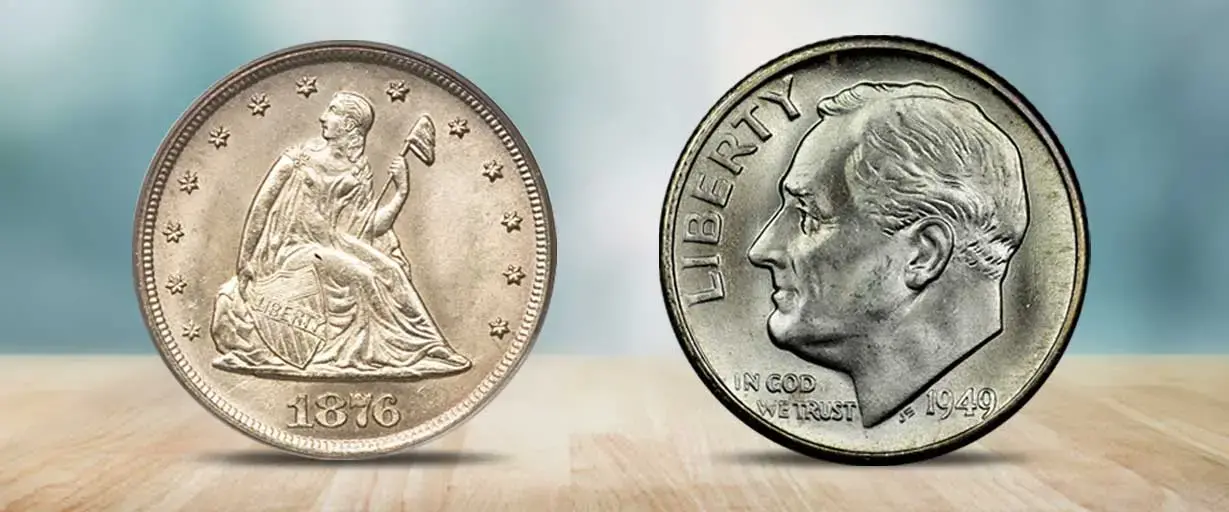We’re back with the next installment in our educational series on coin collecting and numismatics. In this post, we’ll journey through the history and design highlights of two diminutive and intriguing denominations—the dime and the short-lived twenty-cent piece. Let’s dive in and explore some small but mighty coins.
A History of United States Dimes
The dime has held an important place in American commerce and numismatics since the nation’s early days. First authorized in 1792 alongside other silver denominations, the first dimes bearing a depiction of Liberty were struck for circulation in 1796. This inaugural “Draped Bust” design by Robert Scot gave way to the “Capped Bust” motif of the early 1800s. Christian Gobrecht’s Seated Liberty ultimately ran from 1837 to 1891, bringing greater artistry and detail through the years of pattern and varietal changes.
The turn of the 20th century ushered in two of the most widely collected and iconic dime designs—Adolph A. Weinman’s Winged Liberty Head (Mercury) and John R. Sinnock’s profile honoring Franklin D. Roosevelt. Weinman’s obverse featuring Lady Liberty in a winged Phrygian cap, symbolizing freedom and the pursuit of liberty, ran from 1916 to 1945, overlapping with FDR’s storied presidency. Sinnock’s design debuted in 1946 and remains on the Roosevelt dime today.
Along the way, the 90% silver composition gave way to clad copper and nickel in 1965. Key dates like the 1894-S Barber, 1916-D Mercury, and 1949-S Roosevelt draw intense collector attention and premiums due to very low original mintages. Alongside business strike circulation issues, captivating proof editions add diversity for numismatists assembling advanced date and type sets.
The Short-Lived Twenty Cent Piece
Joining the Seated Liberty dime in 1875 was a short-lived counterpart denomination—the twenty-cent piece. As its name denotes, this new coin contained one-fifth the silver content of the prevailing dollar coin. The motivation behind its creation was to spur the use of smaller denomination silver in commerce, as larger coins were heavily hoarded during the economic turmoil of the early 1870s.
Designed by Mint Engraver William Barber, the obverse featured a left-facing Seated Liberty motif similar to the dime. The reverse depicted an eagle perched on a shield with six arrows representing the nation’s motto, “E Pluribus Unum,” which literally means “Out of Many.” But while legally authorized as tender, the cumbersome twenty-cent piece failed to gain favor and traction with the American public. Just under 1.4 million examples were struck for circulation in 1875 and 1876 at the Philadelphia, Carson City, and San Francisco Mints before the series ended abruptly.
Surviving specimens are elusive today, with the date and mintmark varieties highly coveted by series specialists and registry set collectors. The “CC” issues from the Carson City Mint carry substantial premiums due to tiny original outputs of just 133,290 pieces.
Diving Into Twenty Cent Piece Details
The circulated twenty cent piece coins were minted in only two years: 1875 & 1876. Proofs were made in 1877 & 1878 and were not meant for circulation. This is one of the shortest mintages for only 4 years, from 1875-1878. This coin created a lot of confusion, with the quarter dollar still being circulated. The twenty-cent piece featured a diameter of 22mm and a standard weight of 5 grams, with lighter varieties known for 1876. Obverses depicted William Barber’s Seated Liberty design but lacked the “In God We Trust” motto above the dominant central figure. This was added in 1876 amid controversy over supposed hidden arrows in the adjacent laurel leaves pointing to the statement “Deo Vindice” on the ribbon. Reverses displayed the heraldic eagle, shield, and arrow symbolism.
While featuring the same .900 silver composition as other denominations of the era, the twenty-cent coin’s abundance of space between design elements created problems with weak strikes. Finding examples with sharp detail throughout requires selectively seeking out above-average strikes. Toning in attractive colors adds appeal but may hide surface marks. Scrutinizing fields under a loupe is advised.
The “CC” Carson City issues are the undisputed keys. But even the higher mintage Philadelphia and San Francisco versions can prove challenging in grades like MS63 and above. We encourage consulting our expert staff to locate select pieces that balance eye appeal, sharp strike, original surfaces, and attractive pricing.
We hope you’ve enjoyed this glimpse into two fascinating denominations. Stay tuned for future installments in our educational series on numismatics and American coinage history. In the meantime, visit our website or stop by our showroom in Chula Vista to view our inventory or discuss building the dime and twenty-cent set that’s right for your budget and collecting goals.
Check out the other parts in this series:
Part 1: An Intro to Collecting Coins and Other Currency
Part 2: Half Cents and Large Cents
Part 3: Proof and Mint Sets & Commemoratives
Part 4: Indian and Lincoln Cents
Part 5: The Forgotten Coins: A Look at Two Cent and Three Cent Pieces

